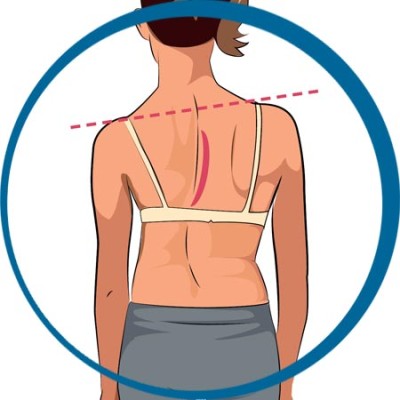Scoliosis is an abnormal sideways curve in the spine of greater than 10 degrees when the spine is viewed from behind in the standing position, and is diagnosed by an x-ray.
Spinal curvature is a complex three dimensional condition that causes twisting of the ribcage and may be accompanied with flattening of normally curved side view of the spine. Scoliosis should not be confused with poor posture. If in doubt, make an appointment for further evaluation.
What causes Scoliosis?
While the actual cause of most scoliosis cases are unknown, it is believed that genetic and certain environmental factors contribute to the beginnings and progression of this spinal condition that affects about 3-5% of the population. Typically, scoliosis will present itself in the adolescent years, starting out as a mild curve that in time, may or may not progress into a more severe spinal deformity. However, adults can begin to display the early stages of scoliosis due to environment and lifestyle factors- like repetitive motions, poor posture, and loss of bone density.


What’s the progression without any intervention?
1 in 4 children with scoliosis are at risk of developing moderate to severe spinal curvature. About 70% of all scoliosis progression occurs during a short 3 year pubertal growth phase. For this reason, if a scoliotic curve is found in the growing adolescent, it is very important that the curves be monitored for change by periodic examination and standing x-rays. The scoliosis may continue to progress into adulthood but at a slower pace.
Preventing further curve progression
While there have been many forms of braces that have been developed over the years, the long-term effectiveness of bracing has not been shown to prevent further progression, or aid in restoring spinal stability or increased flexibility. Bracing is commonly recommended for children aged 10-15 with a curvature between 25 and 45 degrees.
Using scoliosis brace long term, for the recommended 18-23 hours a day, results in the spine becoming stiff due to lack of movement, as well as the muscles of the spine becoming weak due to atrophy. Other side effects from bracing may include, onset of pain that didn’t exist before, and breathing problems due to stress on the ribs. Studies suggest that children say, full-day bracing hurts, is embarrassing, and handicaps their lives.
If a scoliosis brace has been recommended, you deserve a second opinion. In a small number of patients, surgical intervention may be required.
Chiropractic approach to scoliosis
Scoliosis is primarily caused by the brain not being able to maintain or restore posture and balance. When normally functioning, the brain should be able to recognize that the spine is out of alignment and trigger auto-correction mechanisms to fix the abnormal curvature.
For this reason, chiropractors view scoliosis as a neurological rather than purely a physical condition. Therefore, chiropractic approach is to perform spinal adjustments and give specialized scoliosis exercise treatment to create a stimulus that helps the brain to recognize something is wrong, thereby triggering the subconscious auto-correction response.
While every scoliosis case is unique, specific chiropractic scoliosis treatment and exercise protocol with accompanied nutritional advice, may help to reduce curvature, improve breathing and improve curve mobility.

